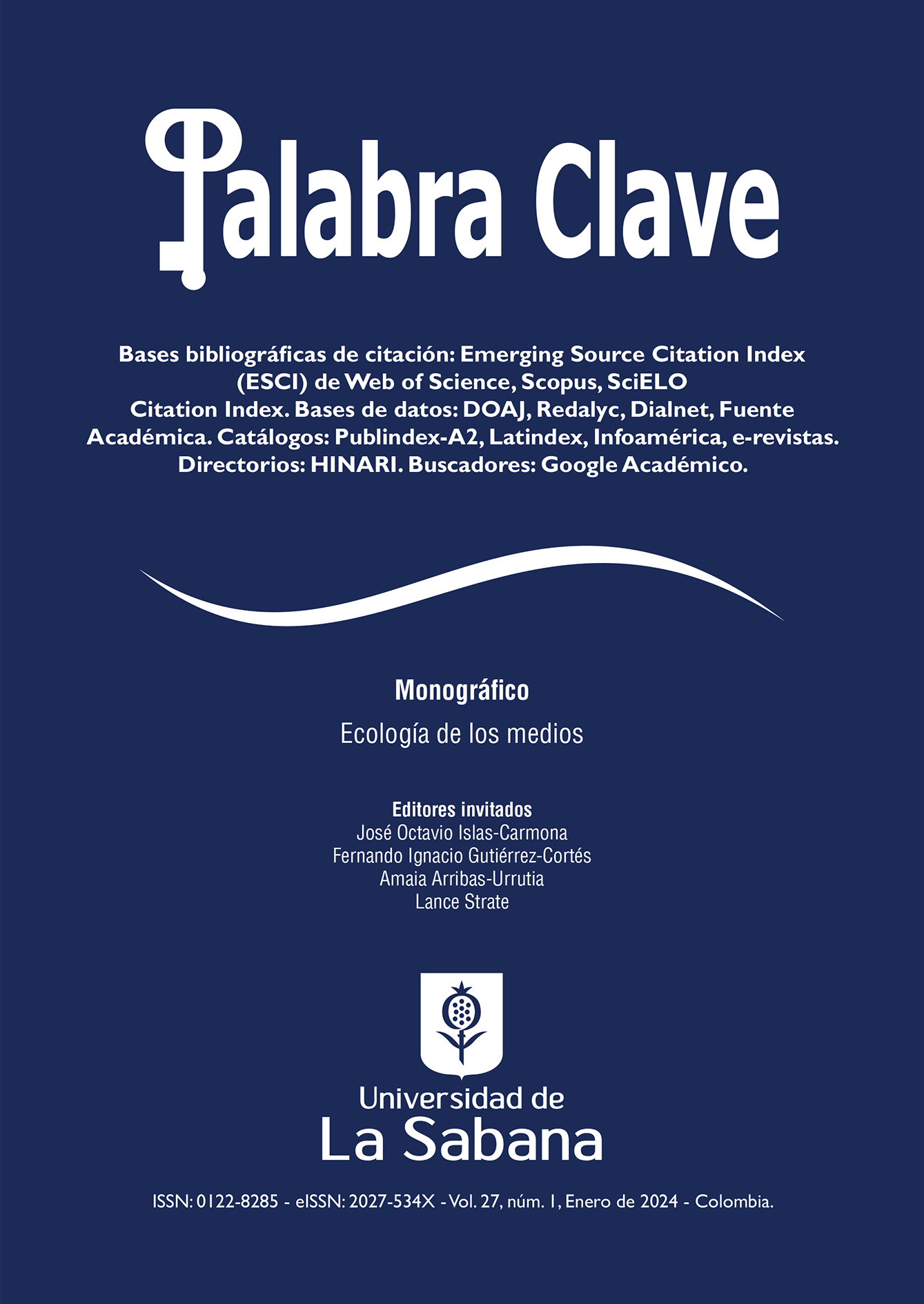Toward a Media Ecology of GenAI: Creative Work in the Era of Automation
DOI:
https://doi.org/10.5294/pacla.2024.27.1.8Keywords:
Automation, creativity, disruption, media ecology, creative industries, generative artificial intelligenceAbstract
Generative artificial intelligence (GenAI) is a complex and compelling machine learning technology that has sparked widespread social debate about its limits and possibilities. An analytical view from media ecology offers a remarkable framework to identify interrelationships between this emerging technology’s problems and challenges. This article delimits the features of GenAI as a medium attached to media ecology and resorts to the conceptual tools of the laws of media (Four Effects) put together by Marshall and Eric McLuhan to reflect on creative work in the era of automation: amplification (or enhancement), obsolescence, retrieval, and reversal. Among the issues addressed are the implications of Gen AI as a technology for encoding representations, the loss of referentiality and traceability of works, the future of intellectual property and its impact on creative industries, and the return and revaluation stand out of shared experiences or performance.
Downloads
References
Aguado, J. M. (2020). Mediaciones ubicuas: ecosistema móvil, gestión de identidad y nuevo espacio público. Gedisa.
Aguado, J. M. y Martínez, I. J. (2005). Epistemología política de la imagen: perspectivas para el análisis de las experiencias culturales en la cultura de masas contemporánea. En Da Silva, J., Bairon, S., Hellín, P. y Cuhna, H. (coords.), Imágenes de la cultura y cultura de las imágenes. Universidade Aberta.
Arenal, A., Armuña, C., Ramos, S., Feijoo, C. y Aguado, J.-M. (2022). Giants with feet of clay: the sustainability of the business models in music streaming services. Profesional de la información, 31(5). https://doi.org/10.3145/epi.2022.sep.09
Baum, S., Barrett, A. y Yampolskiy, R. V. (2017). Modeling and interpreting expert disagreement about artificial superintelligence. Informatica, 41, 419-428.
Benjamin, W. y Zohn, H. (1963). The story-teller: Reflections on the works of Nicolai Leskov. Chicago Review, 16(1), 80-101. https://doi.org/10.2307/25293714
Benjamin, W. (1999). La obra de arte en la época de su reproductibilidad técnica. Astrágalo: Cultura de la Arquitectura y la Ciudad, 11, 77-82. https://doi.org/10.12795/astragalo.1999.i11.10
Cao, Y., Li, S., Liu, Y., Yan, Z., Dai, Y., Yu, P. S. y Sun, L. (2023). A comprehensive survey of AI-generated content (AIGC): A history of generative ai from GAN to ChatGPT. arXiv: 2303.04226. https://doi.org/10.48550/arXiv.2303.04226
CommForum (2010). The Gutenberg parenthesis: Oral tradition and digital technologies. https://commforum.mit.edu/the-gutenberg-parenthesis-oral-tradition-and-digital-technologies-29e1a4fde271
Eco, U. (1982). Lector in fabula. Lumen.
Fontcuberta, J. (2016). La furia de las imágenes: notas sobre la postfotografía. Galaxia Gutenberg.
Jarvis, J. (2023). The Guttenberg parenthesis. The age of print and its lessons for the age of the Internet. Bloomsbury Press. https://doi.org/10.5040/9781501394867
Klippenstein, K. (2023). As actors strike for AI protections, Netflix list 900,000$ job. The Intercept, 25 de julio. https://theintercept.com/2023/07/25/strike-hollywood-ai-disney-netflix/
Manovich, L. (2013). Software takes command. Bloomsbury Academic. https://doi.org/10.5040/9781472544988
McLuhan, M. y Powers, B. R. (1989). The Global Village. Transformations in world life and media in the 21st century. Oxford University Press.
McLuhan, M. y McLuhan, E. (2009). Las leyes de los medios. Cuadernos de Información y Comunicación, 14, 285-316. https://www.redalyc.org/pdf/935/93512977017.pdf
Mumford, L. (1969). El mito de la máquina (vol. 9). Emecé.
Ong, W. (1982). Oralidad y escritura: tecnologías de la palabra. FEC.
Pérez-Amat, R. (2009). Towards a semantic theory of information. TripleC, 7(2), 158-171. https://doi.org/10.31269/triplec.v7i2.108
Radanliev, P., De Roure, D., Maple, C. et al. (2022). Super-forecasting the ‘technological singularity’ risks from artificial intelligence. Evolving Systems, 13, 747-757. https://doi.org/10.1007/s12530-022-09431-7
Regona, M., Yigitcanlar, T., Xia, B. y Li, R. Y. M. (2022). Opportunities and adoption challenges of AI in the construction industry: A prisma review. Journal of Open Innovation: Technology, Market and Complexity, 8(1), 45. https://doi.org/10.3390/joitmc8010045
Sauerberg, L. O. (2009). The Gutenberg parenthesis. Print, book and cognition. Orbis Litterarum, 64, 79-80. https://doi.org/10.1111/j.1600-0730.2009.00962.x
Shannon, C. E. y Weaver, W. (1949). The mathematical theory of communication. University of Illinois Press.
Tencer, D. (2023). 100 million Ai-Generated tracks have been created by Music Platform Mubert. Music Business Worldwide, 12 de julio. https://www.musicbusinessworldwide.com/100-million-tracks-have-been-generated-by-ai-on-music-creation-platform-mubert1/
Turing, A. (1948). Machine Intelligence. En Copeland, B. J. (ed.), The essential Turing: The ideas that gave birth to the computer age. Oxford University Press.
Vaskes, I. (2008). La transestética de Baudrillard: simulacro y arte en la época de simulación total. Estudios de Filosofía, 38, 197-219. http://www.redalyc.org/articulo.oa?id=379846138009
Weber, S. (2022). Mass mediauras; or, Art, aura, and media in the work of Walter Benjamin. En Walter Benjamin (pp. 27-49). Stanford University Press.
Zorpette, G. (2023). Just calm down about Chat GPT and stop confusing performance with competence, says Rodney Brooks. Spectrum-IEEE, 23 de mayo. https://spectrum.ieee.org/gpt-4-calm-down
Downloads
Published
How to Cite
Issue
Section
License
Copyright (c) 2024 Juan Miguel Aguado-Terrón, María del Mar Grandío-Pérez

This work is licensed under a Creative Commons Attribution 4.0 International License.
1. Proposed Policy for Journals That Offer Open Access
Authors who publish with this journal agree to the following terms:
- Authors retain copyright and grant the journal right of first publication with the work simultaneously licensed under a Creative Commons Attribution License that allows others to share the work with an acknowledgement of the work's authorship and initial publication in this journal.
Funding data
-
Agencia Estatal de Investigación
Grant numbers PID2020-114007RB-I00;MCINAEI/10.13039/501100011033








